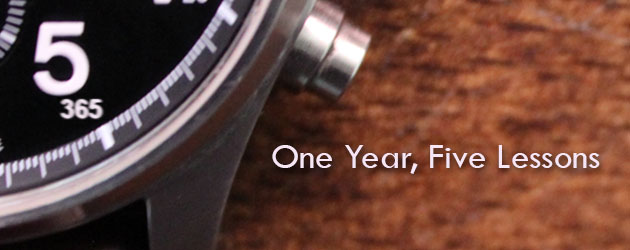The Author, Tim S., is a government relations professional in Washington, DC. He has two boys in diapers and a wife who lovingly tolerates his enthusiasm for the Dallas Cowboys and his style excursions. Except when he speculates that his three-year-old might be nearing the age where he can mix in a pocket square.
I discovered Dappered last fall at a perfect time: I had just turned 40 and moved from a job where the dress code was mostly business casual to a job where it is mostly Dress Like You Are Important. It wasn’t that I dressed badly before: even in hindsight I was probably ahead of 70% of the guys in my demographic. One year of Dappered articles later, I’ve turned over 80 percent of my wardrobe, and strangers routinely ask me for fashion advice. I knew I had progressed when I recently boarded a plane and a flight attendant remarked “Wow, you win the award for best-dressed!” To which my bemused wife (loudly) responded “He’s having a mid-life crisis.” Hey, a prophet is without honor in his own country. But I hope my fellow travelers here at Dappered can benefit from some of the lessons I’ve learned.
Lesson #1: The Johnny Cochrane Rule (if it doesn’t fit…)
As I sit in airports and people-watch, I’m struck not so much that American men dress badly, but that they generally wear the wrong size. Perhaps it is an adolescent insecurity hangover: most boys start picking out their own clothes at a time they want to be bigger and stronger, so moving from “Medium” to “Large” represents progress. It’s the opposite with women, most of whom are delighted if a smaller size fits. My biggest Dappered-inspired “ah-ha” moment came when I realized that most of my clothes were a size too large. Now, I always try on the next size down. And no matter what an items’ “hanger appeal,” if the fit isn’t nearly perfect, I put it back. To paraphrase the immortal Johnny Cochrane “If it doesn’t fit, you must (a)quit,”
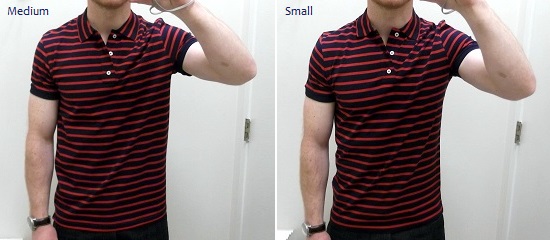
The Epitomizing Item: Bonobos Straight Leg Grey Travel Jeans ($45 new on eBay). Now I know why so many guys swear by these things. For me, nothing fits better than a pair of Bonobos travel jeans. They somehow manage to be snug without being tight, and rugged without being scratchy. I recommend sizing down one inch from your standard jeans size.
The Lesson #2: The Nick Wooster Rule (Jackets win)
When I started reading Dappered and other menswear sites, I noticed the ubiquity and panache of my fellow native-Kansan, Nick Wooster. I could never pull-off his more daring looks (though my one-year old has some camouflage shorts that lead me to call him “Wooster Baby.”) But I was struck by this interview, where Wooster explained “A Jacket is the foundation of a guy’s wardrobe.” It makes sense: whether as part of a suit or just a blazer, a well-tailored jacket is engineered to flatter male proportions. Every guy should own a versatile blazer or three. And remember to do the Shoulder into Wall Trick.
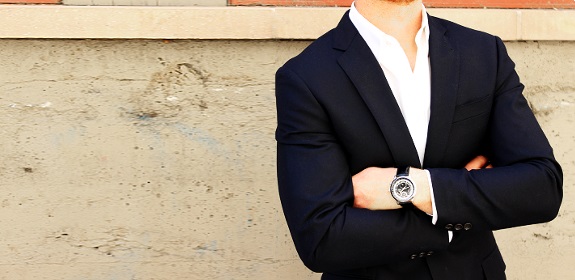
The Epitomizing Item: J. Crew Ludlow Navy Blazer ($150 new on eBay). Retails for $300, with a well-earned spot at the top of the Blue Blazer Hierarchy. A heavier half-canvassed chest piece in luxurious Vitale Barberis Canonico wool. Cut slim and fits me almost perfectly off-the-rack. Hugely versatile. Probably qualifies as my single favorite clothing item.
The Lesson #3: E-Bay is a Convenient Super Thrift Store
Maybe you’re noticing a trend here: I’ve bought a lot of my best stuff on eBay at steep discounts. For those new to it, eBay isn’t the equivalent of a giant attic clearance. It’s like an aggregator of all of the world’s best thrift stores where you can sort through the merchandise without leaving your laptop.
Three tips:
- As with all online shopping, know your size in a particular brand before you buy. I know from in-store experience that I wear a medium in JCrew’s Ludlow dress shirts, so this is a great option for me.
- Look for auctions by non-professional sellers. There is heightened risk with buying from those who are thinly reviewed, but there’s a big upside: infrequent sellers don’t know how to take appealing photographs and write headlines that drive up demand. My tweed Ludlow blazer would have gone for $125+ with an experienced seller, but the seller I purchased it from included neither “J Crew” or “Ludlow” in his headline or ad copy.
- Use Gixen. Gixen is a service that is like hiring an eBay ninja to attend every auction in your place. You choose your maximum bid and walk away. Gixen automatically “snipes” your bid at the last possible second, and if your max is more than required, eBay defaults to a final price “one unit more than the next-highest bid.” That’s usually about a dollar. And Gixen’s basic service is free.
The Epitomizing Item: Ludlow Yorkshire Tweed Blazer ($50 on eBay). Cut slim in Abraham Moon fabric that is softer than most tweeds and versatile enough to be worn most places from fall-through-spring. I’ve worn it three times this year, and I’ve gotten at least one compliment from a stranger each time.
Lesson #4: Amortize (consider the math)
My wife and I had our second child last year, and we completed our slide into American suburbanism by buying an SUV. We paid cash for a 2009 model, and I remember thinking “This car will last for eight or nine years at our projected usage, so this will cost us x per year, etc.” Until recently, I had never thought of buying clothing that way. But we should do the same-kind of cost benefit analysis with most clothing purchases that we do with other depreciable assets. A $300 pair of Goodyear-welted shoes in a venerable style has a seven-to-ten year life expectancy. In total expenditures, that is far superior to my old practice of buying and discarding (uglier) $100 shoes after 18 months of use.
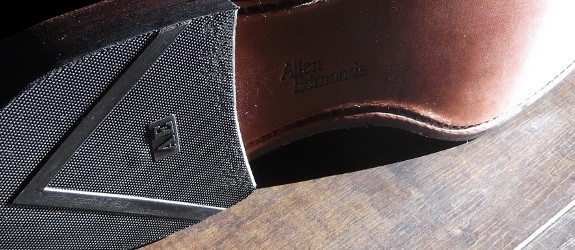
The Epitomizing Item: Allen Edmonds Clifton Oxford in Brown Burgundy ($250 at Nordstrom end-of-year sale). I wear these three or four days a week. Dark enough to work with virtually any suit or jeans. The uncomfortable two-week break-in period gives way to a fit as comfortable as an old pair of sneakers.
Lesson #5: Square Up (pocket, not shoes)
Following the Wooster Rule requires accessorizing alongside your jackets. And the single item under $20 that will give you the highest style return on investment is the pocket square. Even in Washington, DC, where everyone wears a suit and tie, hardly anyone else adds a pocket square. If you are new to the pocket square game, I recommend that your first three purchases be a high quality white linen, a tipped square in a neutral color, and a versatile plaid.
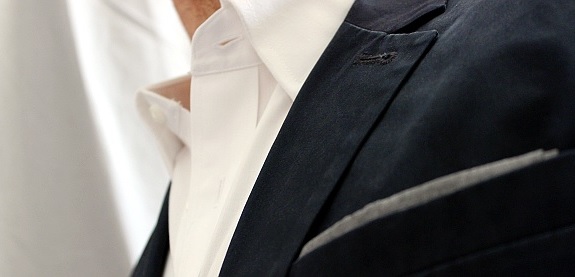
The Epitomizing Item: Tie Bar linen square with navy border ($10) A crisply-pressed linen square is appropriate when dressiness is called for, but can be casually folded into a cotton or tweed blazer. As with navy ties, the color coordinates with a high percentage of suit/tie/shirt combinations.
